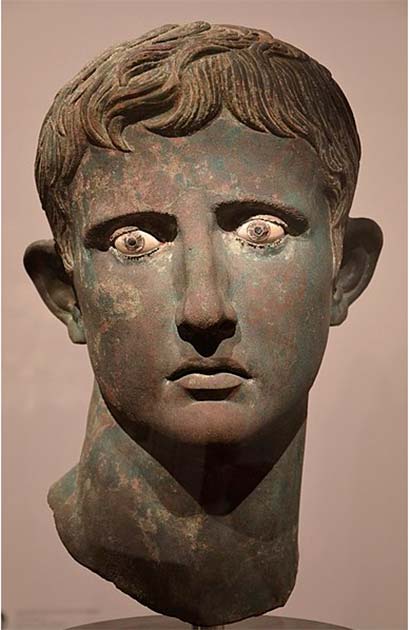
The One-Eyed African Queen Who Defeated the Roman Empire: Amanirenas
Few are those who stood defiant to the powerful Roman Empire and opposed its incessant expansion. From the barbarian tribes of Central Europe to the warlike Britons and Gauls, and all the way to the Kushites of present-day Sudan. Defiance of Rome was for the brave. One powerful queen stood out as a fearsome leader of her people, barring the way for the Romans. Queen Amanirenas, leader of the Kingdom of Kush, waged a terrible war against them from 25 to 22 BC, halting their southward expansion in Africa. Here is her tale.
Queen Amanirenas Leads Her People to Salvation
Queen Amanirenas, also known as Amanirenas of Kush, was a powerful ruler of the Kingdom of Kush, an ancient African civilization that existed from around 1070 BC to 550 AD. Queen Amanirenas reigned during the first century BC and is remembered as one of the most influential and successful queens of Kush. Kush was a powerful civilization located in the region of Nubia, which encompassed parts of modern-day Sudan, Egypt, and South Sudan.
It was known for its wealth, advanced culture, and military strength, often challenging the influence of its northern neighbor, Ancient Egypt.
Known in her native land as Amnirense qore li kdwe li ("Ameniras, qore and kandake"), she was one of the most prominent rulers of her time. The native language of the Kingdom of Kush, Meroitic, is still undeciphered and remains an enigma. However, the titles “qore” and “kandake” tell us that she was an independently ruling queen. Being able to remain independent and powerful facing neighbors such as the Egyptians and the Romans was definitely a commendable feat, telling us that the Kushites were almost equal to their enemies - no small thing. It is interesting to mention that Queen Amanirenas was, according to Greek historian Strabo, completely blind in one eye. Because of this, she is often called “the one-eyed queen”.

A comic inspired by the story of Amanirenas. (Chris Walker/CC BY-SA)
Amanirenas, born around 57 BC, belonged to the Meroitic dynasty, which ruled over the Kingdom of Kush from their capital city, Meroë, after which it is named. This affluent city was the political and cultural center of Kush after the decline of the preceding Napatan dynasty. The Meroitic dynasty was also notable for its tradition of powerful female rulers who held significant authority and played crucial roles in governing the kingdom. Thus, Queen Amanirenas followed in the footsteps of her predecessors, such as Queen Amanishakheto and Queen Shanakdakhete, who were renowned for their leadership and military achievements. Their might did not differ from male rulers. However, Amanirenas would face one of the greatest challenges up to that point - Rome.
- Never Mind Cleopatra – What About the Forgotten Queens of Nubia?
- The rich history of the ancient Nubian Kingdom of Dongola
Against the Greatest Empire in the World
The exact circumstances of Amanirenas' ascension to the throne are not well-documented. It is believed that she inherited the position of queen, likely through a hereditary succession system that existed within the Meroitic dynasty. Amanirenas would have undergone traditional rituals and ceremonies to legitimize her rule and gain the support of the nobility and the people. What is more, as a ruler, she would have to prove to her people that she is truly capable of governing Kush. We know that Amanirenas was skilled in many fields, including administration, trade, and defense. More importantly, she was a capable military leader and strategist. This woman was born to be queen - and proved it.

Map of the Kingdom of Kush - 1700 BC. (CC BY 4.0)
However, Amanirenas was born in a difficult era. The Kingdom of Kush maintained complex relations with its northern neighbors at the time, particularly Egypt and later, the Roman Empire.
Egypt, under the rule of the Macedonian Greek Ptolemaic dynasty, exerted influence over Nubia, leading to occasional conflicts and alliances between the two regions. The two were largely in conflict for centuries up to that point.
However, when the Roman Empire, under Emperor Augustus, expanded its territories into Egypt, it brought Kush into direct confrontation with the powerful Roman forces. Important for its strategic position and its resources, Egypt was a direct gateway to southward expansion and even more wealth. But one defiant, one-eyed queen was adamant to stop them.
In the early 1st century BC, the Romans launched a military campaign to annex the Kushite territories and assert their dominance in the region. They aimed to secure the southern borders of their newly acquired province of Egypt and gain control over the lucrative trade routes that passed through the Kingdom of Kush. But even before they could launch a direct invasion into Kush, Queen Amanirenas reacted proactively. Defending her kingdom's independence, she rallied her forces and launched a counter offensive against the Roman armies, engaging in a series of military campaigns.

The ruins of the temple of Amun in Napata, destroyed by the Romans in 22 BC, Sudan. (Bertramz/CC BY 3.0)
A Decisive and Fierce Kushite Strike
While the Roman prefect of Egypt, Gaius Aelius Gallus, was away fighting in Arabia in 25 BC, Amanirenas used the opportunity to strike. She launched a surprise invasion into Roman Egypt, and successfully captured important cities - Elephantine, Syene, and Philae. Upon capture, the citizens were enslaved, and many Roman relics were destroyed. Most notable was the destruction of statues of Caesar Augustus, which served as an insult to the Roman Emperor.
One such relic became known today as the Meroë Head - a life-size bronze head of Emperor Augustus that was ceremonially buried beneath the steps of a Kushite temple. Thus, Queen Amanirenas could symbolically step on his head, as a victor.

Bronze head from a life-sized statue of Augustus, found in the ancient Nubian site of Meroë in Sudan, 27 - 25 BC. (Following Hadrian/CC BY-SA 2.0)
The war against the Romans was fierce. After the initial surprise attacks, the Romans retaliated - in force. The new prefect, Gaius Publius Petronius, assembled a powerful army of around 10,000 infantry and 800 cavalry, marching them against a Kushite army of 30,000. The two forces clashed at Syene, where the Kushites reportedly fought using “large, oblong shields made of raw ox-hide” and simple weaponry such as axes, pikes, and swords. Because the Roman army was much better disciplined and equipped with state-of-the-art weapons and armor, they managed to defeat the Kushites and send them into a retreat.
During this time, Amanirenas was in the city of Napata, with her son. Gaius Petronius sought to capitalize on his victory, and thus marched towards the temple complex at Pselchis, taking it, and then moving to Premnis. These were two important Kushite locations. Seeing this turn of events, Amanirenas, in her rational judgment, sent envoys to the Romans, telling “that she would return both the captives taken in Syene and the statues of Caesar”. The Romans ignored her offer completely and proceeded to raze Pselchis to the ground. Many Kushite prisoners were taken at this time.
A Bitter Feud With Rome
Seeking to use the situation to her advantage, Amanirenas ordered an attack on the Roman garrison that was left behind at the conquered city of Premnis. According to Strabo, she had many thousands of men at her command. However, Gaius Petronius once more proved his worth as he outmaneuvered her, getting his army to the city before the Kushites arrived. No battle was fought, as the Queen sent ambassadors, which were directed directly to Augustus. As a result, a peace treaty was reached, as both Queen Amanirenas and Emperor Augustus recognized the need for a resolution. This brought the war to an end.
The peace treaty worked largely in Kushite favor. Seeing their resistance, the Romans realized the futility of further invasion. It would be costly in every regard. They still ruled in Egypt, and their southern border stopped at the Kingdom of Kush. The Meroites were exempt from paying tribute to the Empire. The treaty also allowed the Romans to continue to occupy the so-called Dodekashoinos (“Twelve-Mile Lands”), a region that served as a military border zone. Thus, the two realms were separated, and no further conflict ensued.
This peace treaty remained active until the end of the third century AD. During this time, the relations between the Kushites and Roman Egypt remained mostly peaceful. Thus, the Kingdom of Kush remained a formidable power in the region, until its decline during the second century AD. But it was ultimately thanks to Queen Amanirenas defiance and wish for independence that the Romans understood that further southern expansion was simply not possible. The one-eyed Queen saved her realm.
- ‘Gold and the Gods’ opens window to rulers of ancient Nubia
- Asian and Nubian Influences Found In Ptolemaic Era Statues in Berenice
A Heritage for the Ages
Queen Amanirenas' resistance against the Roman Empire demonstrated her determination and military prowess. Her successful defense of the Kingdom of Kush and her ability to negotiate a favorable peace treaty preserved the independence of her realm and secured its borders against Roman expansion. The conflict serves as a testament to her leadership and the strength of the Kushite civilization. But there are other relics that speak of their defiance. The Meroë Head, for example, was the proof that the Romans were - ultimately - not all-powerful.
Even when peace was achieved, the head - one of the most important Roman relics - was not returned. That could be seen as a pretty big statement, since the head was that of the Roman Emperor himself. To have it remain buried beneath temple stairs was a major disgrace, one that would never be remedied. The head was excavated in 1910 for the first time since.
That the final peace was a certain victory for Amanirenas and the Kushites is documented on the Hamadab Stela. Also known as the Victory Stela of Amanirenas, it is an ancient monumental inscription that commemorates the military achievements of Queen Amanirenas of the Kingdom of Kush. The stela was discovered in 1912 at the site of Meroë. Made of sandstone, it stands approximately 7 feet (2.1 m) tall and features inscriptions in Meroitic script. In total, there are 45 rows of incised and cursive Meroitic text, mentioning Queen Amanirenas, as well as King Akinidad, who was likely her husband. There was also an incised image of the royal couple, accompanied by several deities, but the image was since lost. The Queen is depicted alongside bound prisoners, and it is likely that the stela was erected to commemorate her achievements against the Romans. One word, “Areme”, can be recognized, and it was likely the Meoritic word for “Rome”.

Victory Stela of Amanirenas, also known as the Hamadab Stela. (Jononmac46/CC BY-SA 3.0)
A Queen of an Ancient Lost Kingdom
Queen Amanirenas' rise to power occurred within the context of a vibrant and influential kingdom that had a tradition of strong female rulers. Her position as queen provided her with the authority to lead her kingdom and confront external threats, ultimately leading to her renowned resistance against the Roman Empire. This serves as a statement that, in spite of popular misconceptions, women in the ancient world could be exceedingly powerful and independent.
Sadly, the Meroitic language remains a mystery. If, one day, it happens to be deciphered, who knows what wondrous new things we could learn - not just about the one-eyed Queen Amanirenas, but about the Kingdom of Kush as a whole.
Top image: Queen Amanirenas, warrior queen AI representation. Source: Refineria AI/adobe Stock
References
Fage, J. D. and Oliver, R. A. 1975. The Cambridge History of Africa, Volume 2. Cambridge University Press.
Harkless, D. N. 2006. Nubian Pharaohs and Meroitic Kings: The Kingdom of Kush. AuthorHouse.
Török, L. 2015. The Kingdom of Kush: Handbook of the Napatan-Meroitic Civilization. BRILL.















